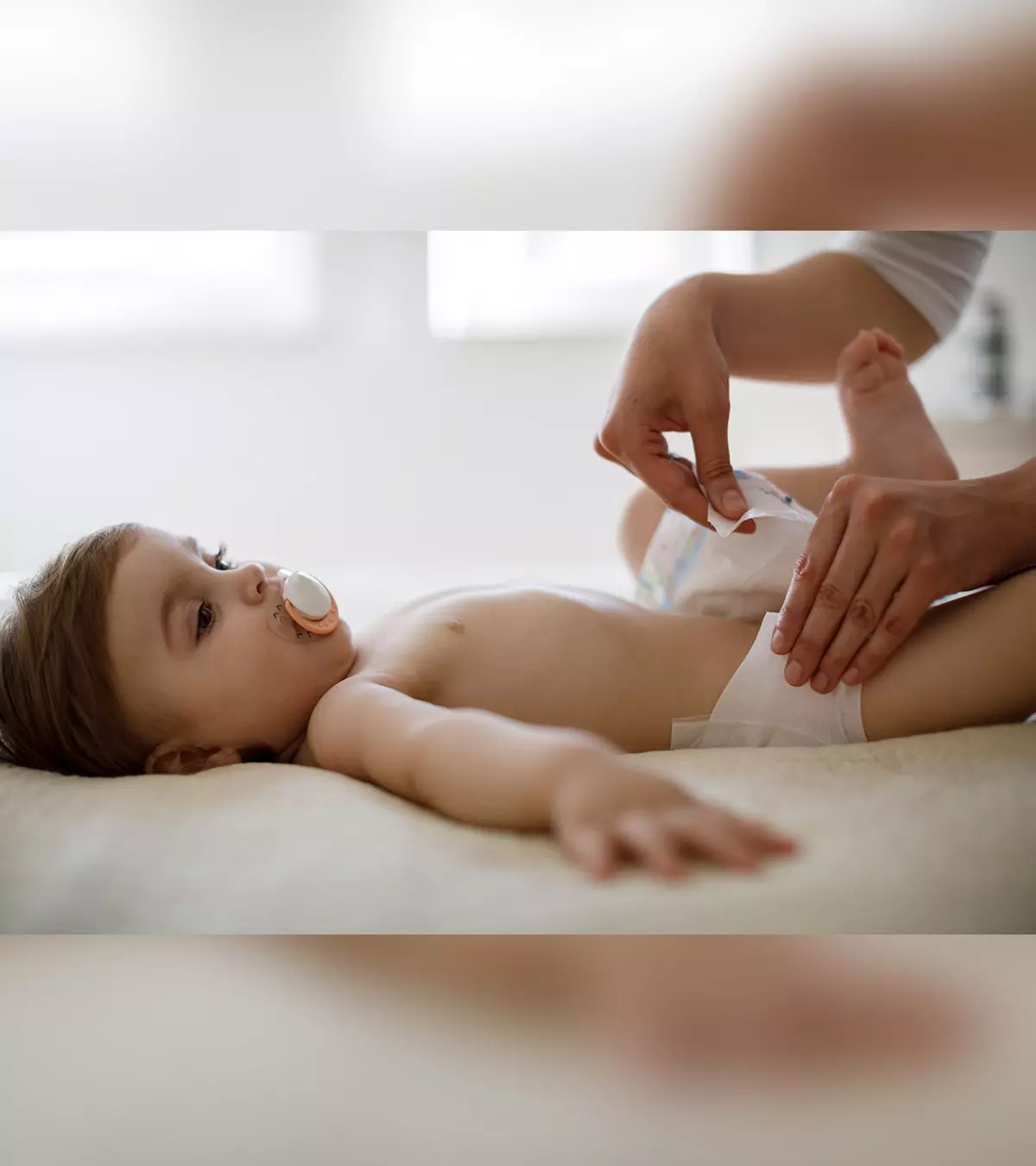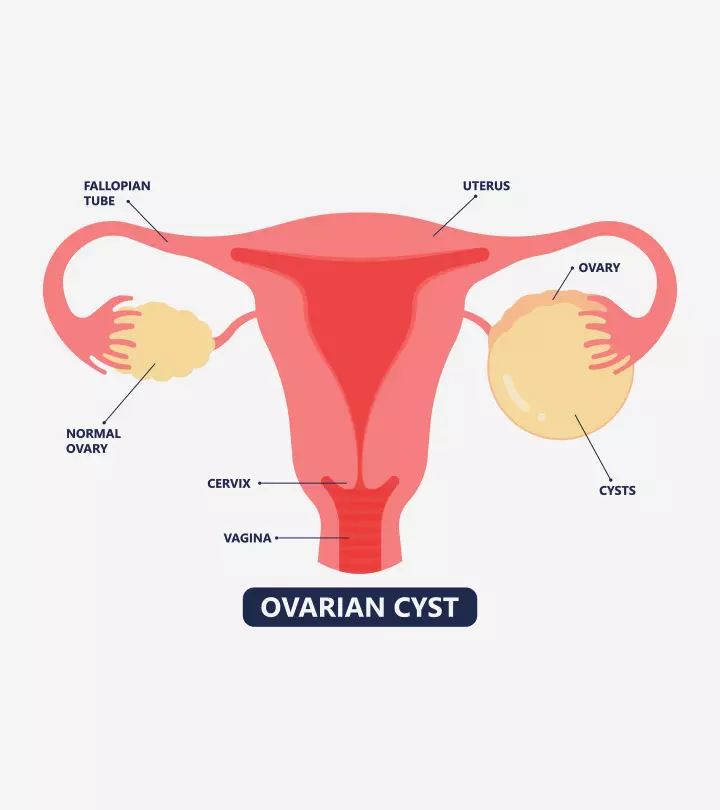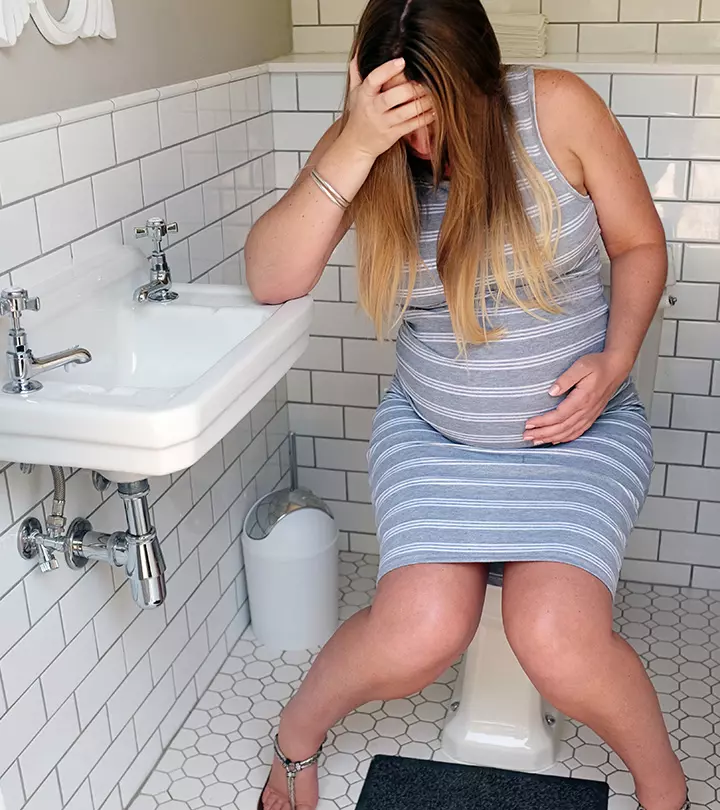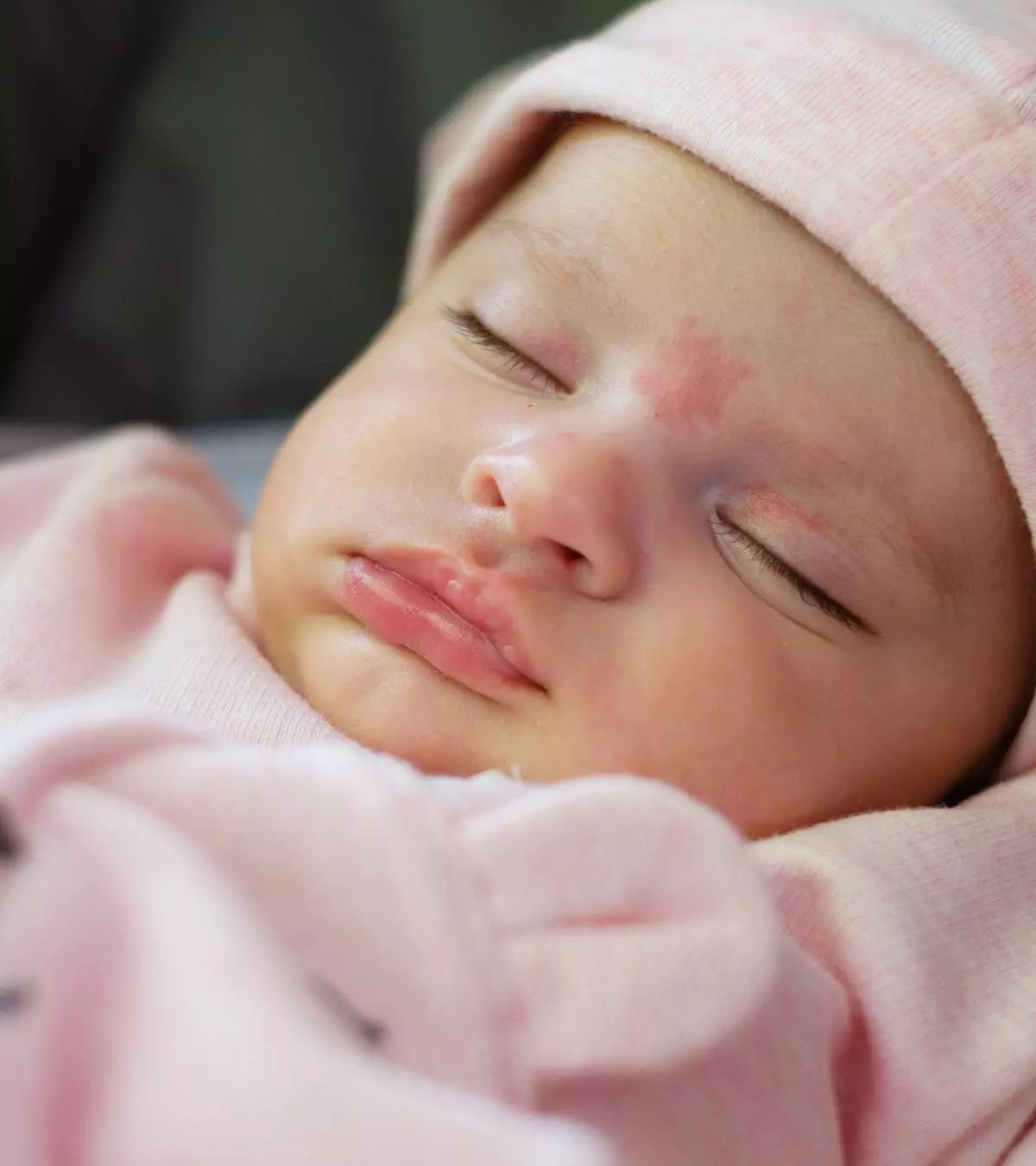
Image: Shutterstock
Stork bite birthmarks, also known as, angel kisses, or salmon patches, are pinkish or reddish patches on the neonatal skin. While babies may have different types of birthmarks, including moles and port-wine stains, stork bite birthmarks are collections of blood on the skin from tiny blood vessels called capillaries. Most babies have stork bite birthmarks on their eyelids, between the eyes, or on the back of their neck above the hairline. They are common and seen in approximately one-third of all newborns at birth (1). Read on to learn about the causes, treatment, and prevention of stork bites birthmarks and how to differentiate them from other birthmarks.

Key Pointers
- A stork bite, medically known as nevus simplex and nevus flammeus nuchae, may occur when a cluster of blood vessels underneath the skin remains stretched.
- The birthmark appears as a red or pink flat patch on the neck, forehead, eyelids, or some other places.
- It usually lightens as the baby grows and seldom requires treatment.
What Is A Stork Bite?

A stork bite, also known as a salmon patch, is a reddish or pinkish birthmark in newborns. It may occur on the eyelids, nose, upper lip, neck, and forehead. The term ‘stork bite’ is usually used when the birthmark occurs on the nape (back of the neck). A stork bite is called an angel’s kiss when it occurs on the forehead (2).
Dr. David G. Li, a board-certified dermatologist from Boston, Massachusetts, says, “Stork bites, also known as nevus simplex, salmon patches, or angel’s kiss, are quite common in newborns and typically don’t indicate any underlying condition. They are categorized under capillary malformations involving tiny blood vessels under the skin. Stork bites can appear on the face, forehead, and posterior neck/nuchal area. Sometimes, a variant of the nevus simplex can warrant additional workup, for instance, if it is located over the lower back or the tailbone area.”
The medical terms for stork bite are nevus simplex and nevus flammeus nuchae (3). The name ‘stork bite’ is derived from the myth that the mark on the back of the neck appears because it is where the stork may have picked up the baby.
The birthmark appears in around 30% of babies (4). Stork bites are relatively harmless and not life-threatening. The marks may fade away by the age of two, but stork bites on the nape tend to be permanent (5) (6).
What Causes A Stork Bite?
Stork bites are a type of vascular birthmark, which occur due to anomalies in the blood vessels (7). A stork bite may occur when a cluster of blood vessels (capillaries) underneath the skin remains dilated (stretched) (8). These birthmarks tend to darken when the baby cries or when the temperature rises. Stork bites may fade away when pressed.
The birthmark is cosmetic and does not require any specific medical diagnosis. A doctor will usually identify stork bites at birth through visual inspection alone.
 Quick fact
Quick factSigns Of Stork Bite

A stork bite is not painful and does not cause any symptoms for the baby. The following are the signs of stork bite that parents may notice (3) (4).
- Red or pink flat patch on the skin
- Present at birth or may appear in the first few months after birth
- Present on the forehead, back of the neck, eyelids, nose, upper lip, or other parts of the body
- Tends to become darker when the baby cries, feels warm, or when straining
- Could fade or disappear when pressed
- Does not grow large and does not disappear and reappear
Alli, a mother, shares her experience with her son Niko’s stork bite. She explains, “A stork bite is a red mark – looks like a birthmark – at the back of some babies’ necks, and Niko has one… You can only see Niko’s if you are looking for it, as it is hidden by his cute mullet-like hair, but it is there and becomes more pronounced when he is upset. Actually, not only does that one become redder with his mood, but so does another one that is hidden higher up on the back of his head (i).”
How Is A Stork Bite Different From Other Birthmarks?
There are several types of birthmarks. Below are the common ones and their differences (3).
- Strawberry birthmark: It is also a type of vascular birthmark. These are also known as strawberry hemangiomas and are bright or dark red in color. A study suggests that strawberry birthmarks occur in up to one in ten infants, though many cases go unnoticed or unreported (9). They differ from stork bites due to their swollen appearance. The bumpy characteristic of the birthmark makes it resemble a strawberry, hence the name strawberry mark. Unlike a stork bite, a strawberry birthmark tends to grow larger, especially in the first six to 12 months of the baby’s life. They also stay for longer and may fade away between the ages of seven and nine years.
- Port-wine stain birthmark: It is another type of vascular birthmark, which occurs due to dilated blood capillaries. Port-wine stains are different from stork bites since they usually do not disappear and may get darker and thicker with time. A port-wine stain in babies will not fade or disappear when pressed. It may often occur on the face and neck. Port-wine stains affect less than 1% of newborns and, in rare instances, could be associated with some underlying problem.
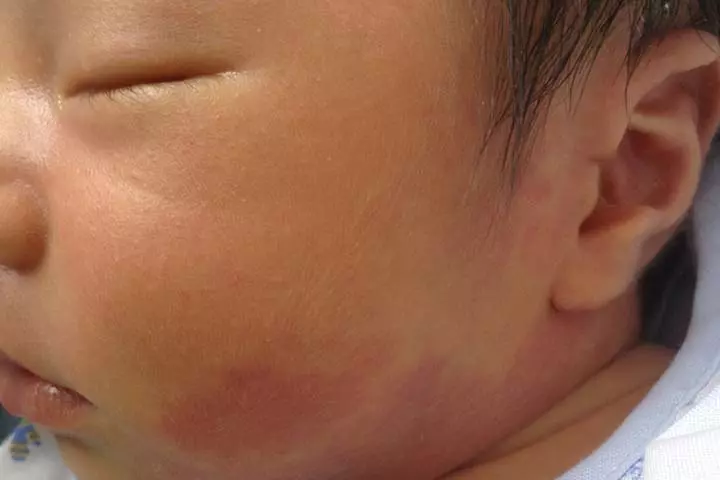
- Moles, café-au-lait, and Mongolian spots: These are called pigmented birthmarks since they occur due to the aggregation of melanocytes or skin pigment cells. Pigmented birthmarks are brownish, bluish, or grayish in appearance compared to the reddish or pinkish appearance of stork bites. Moles tend to stay for longer while Mongolian blue spots fade away as the baby grows older. Café-au-lait spots may or may not fade over time. Research indicates that Mongolian spots occur more often in people of Asian and African heritage, while they are less common in Caucasian populations (10).
Are There Any Natural Treatments For Stork Bites?
According to Harvard Medical School, stork bites do not require treatment (2). These birthmarks do not cause any long-term discomfort or problems for the baby. Parents may consider methods to eliminate or lighten stork bites for cosmetic reasons.
The following are some natural treatments that may lighten stork bites and gradually eliminate them. There is no scientific evidence to back these treatments. Therefore, speak to a pediatrician before trying any of these methods.
- Olive oil: Olive oil is a natural moisturizer that smoothens the skin and lightens dark patches. Dip a cotton ball in olive oil and apply it to the birthmark in a circular motion for five minutes. Wash off with warm water and repeat this process four times a day.

- Lemon juice: Lemon juice acts as a natural bleaching agent and can lighten dark patches on the skin (11). Dilute a few drops of lemon juice with water. Dip a cotton ball in diluted lemon juice and apply it to the stork bite in a circular motion. Wash with warm water. Do it once a day.
- Vitamin A: Vitamin A is usually prescribed for anti-aging and acne treatments, as it stimulates cell division and production of collagen (12). Cosmetic creams with vitamin A may eliminate blemishes and could lighten stork bites. You may apply vitamin A cream once a day to lighten stork bites.
- Vitamin E: Vitamin E has anti-oxidizing properties that can diminish the appearance of damaged skin. Aloe vera is a good source of vitamin E (13). You may apply a small quantity of pure aloe vera gel to stork bites twice a day to lighten the birthmarks.
- Cold compress: A cold compress helps retain skin moisture and may lighten the appearance of birthmarks. Wrap ice cubes in a towel or washcloth and gently place them on the stork bites twice or thrice a day. Never place ice cubes directly on the baby’s skin since it can cause discomfort.
 Health fact
Health factIs Medical Treatment Required For Stork Bites?
Stork bites do not require treatment, as they typically do not affect the baby’s health and fade by the second or third birthday. Parents may consider treatment for cosmetic reasons if the stork bite persists beyond the age of three years (8).
According to research, as children grow older, especially during school years and adolescence, they may become more self-conscious about visible differences. Since friendships and self-image are important at this stage, addressing such conditions early can help improve their self-esteem (14).
Laser treatment is the recommended medical treatment for capillary malformations or anomalies, such as stork bites in babies (15). A pediatric dermatologist would use a laser to shrink the size of the dilated blood vessels and lighten the appearance of the stork bite. Laser treatment is painless and effective but may require multiple visits for desired results based on the stork bite’s size and location. Some parents wait until their baby is older to avoid anesthesia.
Colleen, a mother of six, shares how her baby, Alexander’s, birthmark gradually disappeared by age six without any medical intervention. Alexander was born with a huge red birthmark all over his face. She says, “I was used to seeing stork bites on my other babies, but they were tiny on the eyelid or back of the neck. I was worried about his marks and asked around for what we could do about it.
“My midwife said it occurred because of the position his face was in as he grew in utero. The consensus was to just wait it out. My sister, a dermatologist, said that we could try a laser option but suggested waiting until he was a year old since it was a minor surgery. And so we waited… His birthday is In July, and I think even as the birthmark/stork bite was fading, it would sometimes be more visible when we spent time outside, or he got mad or overheated (ii).” By six years, the birthmark faded almost completely.
Can You Prevent Stork Bites?
There is no way to prevent birthmarks, including stork bites (1). If you spot stork bites on your baby, speak to a doctor who can examine it to determine if it is a birthmark and not a skin disorder. You should also inform the doctor if your baby’s birthmark bleeds, itches, or is painful.
Frequently Asked Questions
1. When do stork marks go away?
The stork bites on the face, forehead, and eyelids may fade between one and two years of age. However, stork bites on the back of the neck or parts of the body may usually last into adulthood (16).
2. Does labor cause stork marks?
No. Stork bites are formed when blood vessels stretch under the skin during fetal development, and there is an increase in blood flow to that area (16).
3. Are stork bites more common than other birthmarks?
Stork bites, also known as salmon patches or angel kisses, are more common than other types of birthmarks, with roughly 80% of babies having them (16).
4. Is there any difference in the texture of a stork bite versus other birthmarks?
Stork bites have a distinct appearance when compared to other birthmarks. They are flat spots on the skin with no clearly defined borders that are commonly observed on the back of the head or neck. Additionally, they are distinguished by a pink to reddish-purple color that contrasts with the baby’s skin tone (16).
5. Does the intensity of a stork bite in babies vary from person to person?
Yes, the intensity of a stork varies from person to person, including babies. The intensity of stork bites in babies varies due to factors such as location, skin tone, and underlying blood vessel structure. It is typical for a stork bite to change color in response to certain behaviors, such as becoming more noticeable when the infant screams or gets warm, and momentarily turning pale when pressure is applied to it (16) (17).
6. Are stork bites hereditary?
Stork bites are harmless birthmarks that are present at the time of birth. However, they are not hereditary.
The stork bite birthmarks are common among newborns and are not a cause for concern. These birthmarks usually appear on the back and neck and fade away as the baby grows. Since these birthmarks in babies rarely cause any discomfort, there is no need for treatment. However, if the mark persists even after three years, a few parents may consider its removal for cosmetic purposes. A stork bite birthmark doesn’t spread and varies with other birthmarks. If you are unsure about the benign nature of the mark, you could always get it checked by a medical professional.
Infographic: Remedies For A Stork Bite
Stork bites are a type of vascular birthmark that appear on about one-third of all babies, making it quite common. This infographic can help you identify the signs and try some natural remedies.
Some thing wrong with infographic shortcode. please verify shortcode syntax
Illustration: Stork Bite Birthmark: Causes Treatment And Prevention

Image: Dall·E/MomJunction Design Team
Personal Experience: Sources
MomJunction articles include first-hand experiences to provide you with better insights through real-life narratives. Here are the sources of personal accounts referenced in this article.
i. Stork Bite;
https://alliwaw.wordpress.com/tag/stork-bite/
ii. The fading birth mark;
https://martinfamilymoments.blogspot.com/2017/12/the-fading-birthmark.html
References
Community Experiences
Join the conversation and become a part of our nurturing community! Share your stories, experiences, and insights to connect with fellow parents.
Read full bio of Dr. Carmela Augusta Dayrit-Castro
- "Dr. David Li is a Harvard-trained board-certified dermatologist practicing general and cosmetic dermatology in downtown Boston, MA. He is the founder of Boston Derm Advocate, which provides reviews on skincare products, trends, and myths. "
 "Dr. David Li is a Harvard-trained board-certified dermatologist practicing general and cosmetic dermatology in downtown Boston, MA. He is the founder of Boston Derm Advocate, which provides reviews on skincare products, trends, and myths. "
"Dr. David Li is a Harvard-trained board-certified dermatologist practicing general and cosmetic dermatology in downtown Boston, MA. He is the founder of Boston Derm Advocate, which provides reviews on skincare products, trends, and myths. "
Read full bio of Dr. Ritika Shah
Read full bio of Rohit Garoo
Read full bio of Shinta Liz Sunny








